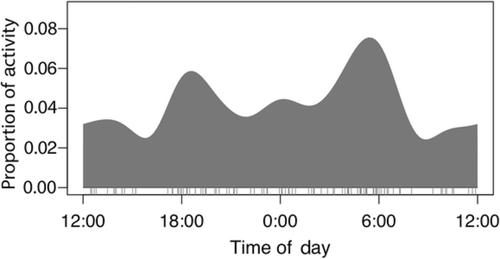当前位置:
X-MOL 学术
›
Ecol. Res.
›
论文详情
Our official English website, www.x-mol.net, welcomes your
feedback! (Note: you will need to create a separate account there.)
Scavenging and carcass caching behavior by European wildcat (Felis silvestris)
Ecological Research ( IF 1.7 ) Pub Date : 2021-02-24 , DOI: 10.1111/1440-1703.12211 Miha Krofel 1 , Damjan Južnič 1 , Maximilian L. Allen 2
Ecological Research ( IF 1.7 ) Pub Date : 2021-02-24 , DOI: 10.1111/1440-1703.12211 Miha Krofel 1 , Damjan Južnič 1 , Maximilian L. Allen 2
Affiliation

|
While scavenging has been repeatedly reported for several felid species, surprisingly little information is available on scavenging behavior of the European wildcat (Felis silvestris). To fill this knowledge gap, we used camera traps to document scavenging behavior at the 48 experimentally set deer carcasses at random locations throughout the year. We recorded European wildcats scavenging on 38% of the eight carcasses set in winter and on none set in the other parts of the year. Wildcats fed on two carcasses for extended periods (up to 22 days) with an average of 3.3 visits per day and 7.8‐h interval between the visits. We recorded scavenging throughout the day, but analysis indicated a crepuscular pattern. We also recorded caching behavior on 7% of the visits (n = 105), when wildcats used leaves or snow to partly or completely cover the carcasses. Beside wildcats, 12 other vertebrate species of scavengers were recorded at the carcasses. We recorded agonistic interaction with European badger (Meles meles) and despite its smaller size, the wildcat managed to defend the carcass. The extensive feeding, frequent caching behavior and active defense from scavengers indicate that the wildcats recognized the ungulate carcasses as an important food source in winter and that scavenging could be a neglected aspect of the European wildcat ecology. We also suggest that caching behavior could be regularly used by the European wildcat when feeding on larger carcasses, but was likely previously missed due to limited research effort to record scavenging and caching behavior.
中文翻译:

欧洲野猫(Felis silvestris)的清除和car体缓存行为
尽管已经多次报道了几种猫科动物的清除行为,但令人惊讶的是,几乎没有关于欧洲野猫(Felis silvestris)清除行为的信息。为了填补这一知识空白,我们使用照相机陷阱记录了全年在随机位置上的48个实验设置的鹿car体的清除行为。我们记录了欧洲野猫在冬季设置的8个cas体中清除了38%的情况,而在一年中的其他部分则没有进行清除。野猫在两个屠体上喂食时间延长(最多22天),平均每天探访3.3次,两次探访之间的间隔时间为7.8小时。我们记录了全天的清理活动,但分析表明是裂缝型的。我们还记录了7%的访问的缓存行为(n= 105),当野猫用树叶或雪覆盖部分或全部尸体时。除野猫外,尸体上还记录了其他12种脊椎动物的清道夫。我们记录了与欧洲badge(Meles meles)的激烈互动,尽管它的体型较小,但野猫还是设法保卫了cas体。广泛的进食,频繁的缓存行为和清除剂的积极防御表明,野猫将有蹄类动物的recognized体视为冬季重要的食物来源,而清除工作可能是欧洲野猫生态中被忽视的一个方面。我们还建议,欧洲野猫以较大的尸体为食时可能会定期使用缓存行为,但是由于记录清理和缓存行为的研究工作有限,以前可能会错过这种行为。
更新日期:2021-02-24
中文翻译:

欧洲野猫(Felis silvestris)的清除和car体缓存行为
尽管已经多次报道了几种猫科动物的清除行为,但令人惊讶的是,几乎没有关于欧洲野猫(Felis silvestris)清除行为的信息。为了填补这一知识空白,我们使用照相机陷阱记录了全年在随机位置上的48个实验设置的鹿car体的清除行为。我们记录了欧洲野猫在冬季设置的8个cas体中清除了38%的情况,而在一年中的其他部分则没有进行清除。野猫在两个屠体上喂食时间延长(最多22天),平均每天探访3.3次,两次探访之间的间隔时间为7.8小时。我们记录了全天的清理活动,但分析表明是裂缝型的。我们还记录了7%的访问的缓存行为(n= 105),当野猫用树叶或雪覆盖部分或全部尸体时。除野猫外,尸体上还记录了其他12种脊椎动物的清道夫。我们记录了与欧洲badge(Meles meles)的激烈互动,尽管它的体型较小,但野猫还是设法保卫了cas体。广泛的进食,频繁的缓存行为和清除剂的积极防御表明,野猫将有蹄类动物的recognized体视为冬季重要的食物来源,而清除工作可能是欧洲野猫生态中被忽视的一个方面。我们还建议,欧洲野猫以较大的尸体为食时可能会定期使用缓存行为,但是由于记录清理和缓存行为的研究工作有限,以前可能会错过这种行为。











































 京公网安备 11010802027423号
京公网安备 11010802027423号